
1939 Velocette Roarer Replica
Engine: 498cc air-cooled supercharged SOHC parallel twin w/two counter-rotating crankshafts, 68mm x 68.25mm bore and stroke, 7.5:1 compression ratio, 54hp @ 4psi boost (est.)
Top speed: 140mph (est.)
Carburetion: Single Amal 10TT9 w/Shorrock-type supercharger
Transmission: 4-speed, shaft final drive
Frame/wheelbase: Steel tube frame/55in (1,397mm)
Suspension: Girder fork front, dual shocks rear
Brakes: 8in SLS drums front and rear
Tires: 3 x 19in front, 90/90 x 18 in rear
Weight: 350lb (159kg) (est.)

Just as important is the density of air the engine is breathing, which depends on temperature and atmospheric pressure. Cold air is more dense than warm air. And atmospheric pressure is affected by altitude — the higher you go, the less dense the air. So how can you improve volumetric efficiency, and therefore increase power, assuming timing and intake tracts are already optimized?
This was the challenge piston-engine designers wrestled with during the 1920s and 1930s — especially in the aircraft industry. As aircraft flew higher, the density of the air their engines breathed was reduced. That meant their volumetric efficiency fell, leading to a loss of power at altitude. At 10,000 feet, for example, air is less than two-thirds as dense as at sea level. The answer was to push more air/fuel mixture into the intake so its density could be maintained as the aircraft flew higher. Airplane engines soon featured some sort of compressor: either a supercharger (driven mechanically from the crankshaft), or a turbocharger (driven by exhaust gases).
That’s not to say Britain’s bike makers ignored this trend. Velocette experimented with a supercharged KTT overhead cam single in 1931, producing the motorcycle known as “Whiffling Clara.” Perhaps the most ambitious attempt to harness the technology was the AJS V4 of 1935 (MotorcycleClassics, January/February 2011). The prototype single overhead cam V4 was never fully developed, but was intended to be supercharged and liquid cooled. Meanwhile, over at the Velocette works in Hall Green, Birmingham, chief designer Charles Udall had laid out a unique design for a 500cc parallel twin that was designed specifically to use supercharging.
The Roarer
Through the 1930s, Velocette and Norton dominated the 350cc and 500cc classes in the Isle of Man TT and other Grand Prix races with their overhead cam singles. But by 1937, it became clear these machines would soon be outclassed by the supercharged BMW twins and DKW 2-strokes. Udall was clearly impressed by the BMW, but was also aware of a major flaw in its design — at least as far as a race bike was concerned. With the engine crankshaft mounted longitudinally, the BMW engine produced significant torque reaction, which either wanted to sit the bike up or increase its lean angle when power was applied in a turn. There was also a considerable gyroscopic effect from the crankshaft, which made the bike resistant to turning.
Udall planned a longitudinal engine, like the BMW, but his clever design eliminated both of the BMW’s handling issues. Instead of two pistons running on a common crankshaft, Udall’s engine had two crankshafts, each aligned along the axis of the motorcycle, not across it. The two crankshafts were geared together such that the two pistons rose and fell together but with the cranks rotating in opposite directions. (Michael Czysz employed a conceptually similar design in the MotoCzysz C1 V4 engine, which also used two longitudinal crankshafts geared together.)
This clever arrangement incorporated the advantages of BMW’s RS255 (its even firing order, for example) but the dual counter-rotating cranks eliminated torque reaction and negated the gyroscopic effect. The design also meant a more compact powertrain and eliminated any problems of ground clearance, a potential issue with the BMW’s horizontal layout. And while BMW’s flat twin reduced primary vibration, the Roarer’s parallel twin would not. Though vibration may be an issue for a street bike, it was of less concern in a racer.
Udall’s design made good use of this unusual layout. One crankshaft drove a supercharger behind the crankcase, while the other crank drove the clutch, gearbox and shaft drive to the rear wheel. The Roarer’s two pistons ran in a common light alloy cylinder block with iron liners, capped with separate “hemi” cylinder heads. A train of gears drove a vertical bevel gear shaft to the two single overhead camshafts operating two valves per cylinder. The cylinder heads were designed with rearward-facing exhaust ports, implying that liquid cooling would eventually be used, as the exhaust headers were at least partially screened from cooling air.
But there was another likely reason for the unusual layout. In a supercharged engine, it’s important to provide a “plenum chamber” between the blower and the intake ports to smooth out pressure pulses from the blower, and to allow the mixture to cool after being heated in the compression process. Routing the intake manifold over the top of the engine to the front allowed a larger volume for the plenum, and meant the manifold and intake tracts got more cooling air, increasing the density of the mixture.
The Roarer also used the latest in rear suspension (swingarm with coil spring/damper units) but with conventional girder front fork. The bolt-up steel tube frame ran on spoked wheels with single-leading-shoe drum brakes.
Unfortunately, the Roarer had only one serious outing, in 1939. The great Stanley Woods, recently moved to Velocette from Moto Guzzi, took the Roarer out in practice for the Isle of Man TT. But the engine experienced overheating problems and was pulled from the race. Of the prototype, it was said that it “steered like a dream and was turbine smooth.”

With the onset of hostilities, Velocette’s focus shifted to military production, and when the FIM (the worldwide motorcycle sanctioning body) banned supercharging in 1947, the Roarer project was abandoned.
Just one prototype was built. It languished at the Hall Green works until it was dismantled, the engine internals removed to reduce weight, and the shell displayed at U.K. motorcycle shows during 1956. Between then and when it was acquired by Velocette guru Ivan Rhodes, the internals had either been lost or rusted away. Rhodes restored the Roarer to working condition, and it has since been run occasionally on racetrack parade laps. It was the only Roarer in existence until…
Dan Smith’s Roarer replica
Dan Smith, Vancouver, British Columbia, considers the 1930s to be pretty much the high point of British motorcycle design. And he has a good case. After World War II, the mass-produced bikes were almost exclusively parallel twins. Smith has built — from scratch — three of the most interesting motorcycles from the pre-war era: a Vincent series A twin, the 1935 AJS V4, and most recently, the 1939 Velocette Roarer. “The three most sophisticated, state-of-the-art engines that came out of the U.K. before the war were the Roarer, the AJS V4 and the Vincent A-twin,” Smith says.
So why take on such a difficult and complex build? “You’re looking for the challenge,” Smith says. Smith started the process, as he did with the AJS, by extrapolating the dimensions from a cutaway drawing in isometric projection, typical of the kind used in magazine illustrations at the time. This painstaking operation meant re-drawing each component in turn, taking dimensions from the cutaway. “Working off this, you start putting something on paper and then you move on to another section, and then you realize that that doesn’t fit, so you have to go back and rub out the first one and then you move up the ladder as you go along,” he says.
Smith did get some help. Upon hearing that Smith was working on a replica, Roarer prototype owner Ivan Rhodes volunteered to assist. Smith sent Rhodes copies of the engineering drawings he had produced, and Rhodes was able to confirm or correct the dimensions. The Roarer has a complex set of engine castings, including five that make up the crankcases. Rhodes was also able to confirm the deck height for the Roarer’s cylinder block. From the stroke length, that gave Smith the required rod length for the Suzuki pistons he planned to use.
“One thing that I was surprised that I got from Ivan was that it was a 100-percent balance on the motor on each crank, and I would never have done that,” Smith says. “And being a vertical twin that’s geared together, the 100-percent balance is just fine. It’s a very smooth motor.”
To get the engine cases made, Smith produced patterns from wood, then had them cast in alloy by Vancouver’s Hastings Foundry, finishing the machining in his own shop. With the cases complete, he moved on to the cylinders and heads. “You move one step at a time and complete the first step before you go to the second step,” he says
Especially complex was the bevel gear drive to the two (one for each cylinder) overhead camshafts. A train of gears from the crankshaft drives a vertical bevel shaft through the cylinder heads to another set of bevel gears driving the two camshafts. The valves use hairpin springs from a NSU Max. “You have to make all this to pull together and get no backlash in the bevel gears,” Smith says. “And then you can only assemble it one way. And you’ve got to do your valve timing. It’s a bear to assemble. But when I’m building it, it all makes sense.”
Getting all the internal oilways right was one of many challenges. “You have to figure out how everything is lubricated. Putting the oil pump [from a BSA] in and then making the gear drive to it, is all fairly straightforward,” Smith says.
As well as the pressure feed to the engine bearings, the Roarer’s gearbox and final drive are also lubricated from the oil pump. “You have to get the details and go through with it from one end to the other,” Smith says. “It’s all internal oilways drilled through. The main gears are lubricated with a nozzle, and then the oil goes into the final drive. It’s all pressure lubricated. So that takes a lot of head scratching. It’s not complicated, it’s just hours, and hours, and hours…”
Another unconventional aspect of the Roarer was the gearbox. Instead of a conventional countershaft gearbox with a layshaft and concentric input/output, the box has only two shafts — input and output — with direct drive in top gear. The bevel gear final drive presented further challenges. After deciding the case was too complex to machine, Smith decided on casting it. That meant making more patterns and cores for the casting process. “I robbed some bearings and seals off a Suzuki,” Smith admits.
Sourcing a suitable supercharger proved to be impossible. The Roarer used a Shorrock-type sliding vane supercharger, but Smith determined that Shorrock never made a model small enough to fit the Roarer, so he had to make one. “People said, “What are you going to do about a blower?” and I said, ‘I’m going to make one.’ Well, I mean, that’s what it’s all about. If it was easy, everybody would be doing this. So I drew it up and made it. It was a nice exercise.”
In a Shorrock blower, a central offset rotor carries a series of vanes that slide in and out as the rotor turns, drawing air/fuel mixture into an oval-section chamber. The chamber tapers away toward the blower’s exhaust port, compressing the mixture as the rotor turns. The compressed mixture is then fed to the engine’s intake. Smith was able to improve on the original design, which required oil mixed in with the fuel to lubricate the blower’s bearings. Using modern sealed bearings, the lubricant was unnecessary.
Cam timing also needs to be different from a naturally aspirated race engine to maintain boost pressure. “I’ve read that they used the cam out of a KSS, and that they had trouble getting their intake pressures up. Well, the overlap on a KSS is quite radical and with a supercharger, you should have zero overlap,” Smith says. “I’ve got reasonable supercharge pressure that is in proportion to the rpm. I was getting 6 pounds at six grand.” Smith expects to get 7-8 pounds of boost at 7,000rpm for a theoretical 12:1 compression. No blow-off valve is fitted, unlike the original Roarer. “Quite surprising, the blow-off valve was right down where the carburetor is. So if it blew, it would be spewing gasoline on hot exhaust pipes. Not a good thing if those pipes are turning red!”
Drive to the magneto, a rare Lucas AC2, required cutting special helical gears, as the mag drive is at right angles to the crank, and running at half crankshaft speed. The engine was assembled using O-ring seals wherever possible, and the finished powertrain is oil-tight. Smith made the hubs and brake drums, fitting Suzuki shoes.
The chassis presented few problems. “The frame is made like a Tinkertoy set. A lot of straight tubes clamped together, so it was fairly straightforward,”& Smith says.
It took Smith a full three years to make the Roarer. The only issue showed up the first time Smith took it to Seattle International Raceway. On shifting up through the gears, Smith realized he had third and fourth gears reversed. Making a new selector camplate fixed that. Aside from a minor clutch pushrod wear issue and getting the carburetion right, the Roarer ran well.
So what was that first ride like? “It was good. I mean, it was a nail-biter because you made the whole thing. You don’t know if you’re going to hit a speed wobble,” he says. Fortunately, he didn’t. Now the challenge Smith has is finding a local track suitable to explore the Roarer’s potential. But not its top speed. Presently, he has it geared for 120mph at 7,000rpm. “For me to do 140 miles an hour on that thing, I’d be crazy!” MC


















